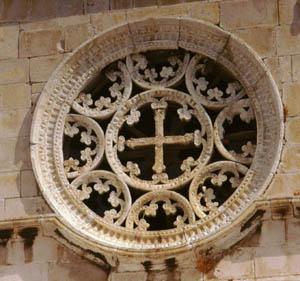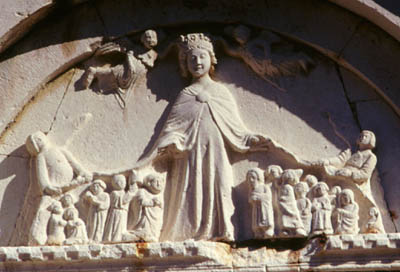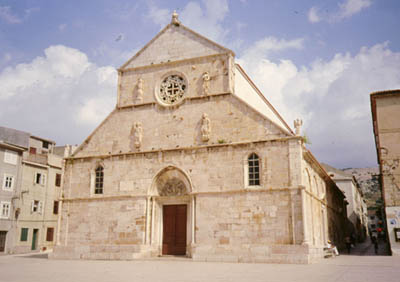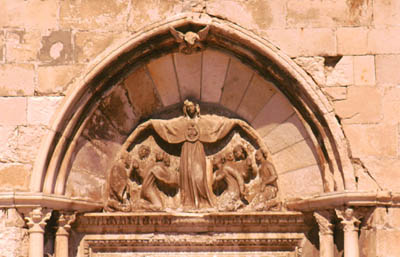Emil Hilje: The Monuments of Mediaeval Architecture on the Island of Pag (summary)
 |
The numerous monuments of mediaeval religious
architecture on the island of Pag are a valuable witness to the development
of mediaeval architecture not merely on Pag, but also throughout the broader
geographic region. Unfortunately, only a few of these structures have
remained in function to the present. Most of these churches are in ruins
today, and many of them have disappeared entirely. It is nonetheless possible
to reconstruct to some extent on the basis of what has been preserved
and also the data offered in archival records the full wealth of the architectural
activity in this period, as well as particular elements in the manner
of construction, and certain stylistic developmental advances. Several churches had already been constructed in Pag as early as the early Christian period, and also during the early mediaeval period. Some of them remained in function afterwards (St Jerome in Vlašići, the older church of the |
| Blessed Virgin in Stari Grad, St Nicholas
at Povljana, St George above Pag, St George at Smokvica, St Peter at Prosika).
The real expansion in architectural activity took place at the end of
the 13th century and during the 14th century, when a large number of small
churches were built next to fields and salt pans, as well as churches
in the town itself. Of the numerous religious structures built at the end of the 13th and in the first half of the 14th century, the majority of those located in the southeastern part of the island belong to the characteristic type of single-naved rectangular churches of small dimensions, with a semicircular apse, roofed with a barrel vault which was strengthened by a horizontal band supported on laterally placed pilasters. The ruined remains of the following churches show that they belonged to this type: St Michael near Gorica, St Martin at Stara Povljana, St Nicholas at Pag Point, and the most attractive of them all, the Church of St Guy on the hill above Kolan. For some churches, such as St Andrew and St John at the salt flats, St Martin in Stari Grad, SS Cosmos and Damian in Stari Grad, and St Gregory near Stari Grad, it is not possible to determine whether they belonged to the same time because of their poor preservation, but the preserved remains indicate a similar plan. In the northwestern part of the island, remains have been preserved from the cited period of the churches of St Christopher near Stara Novalja, St George at Caska, St Guy at Vidasovi Stanovi, St John near Jakišnica, St Martin at the tip of Lun Point, and St Andrew near Novalja. In contrast to those in the southeastern part of the island, these churches exhibit neither typologic nor stylistic uniformity, and the two constructed on the Lun peninsula, which was owned by inhabitants of the adjacent island of Rab (St Guy and St John), are stylistically more advanced than the contemporary structures in other sections of the island. The greatest number, however, of the religious structures from the end of the 13th century and from the 14th century disappeared entirely (or the structures were later remodelled completely). The following churches are known merely on the basis of archival records: St Ambrose, St Andrew, St Francis, St George, the Holy Cross, St Margaret, and St Matthew in Stari Grad, St Maurus at Barbat, St Quirinus near Pag, St Euphemia and St Stephen near the salt pans, St Maurus at Dinjiška, the Holy Cross at Stara Vasa, St Catherine at Novalja, and St Anthony in the Novalja plain. The large church of the Our Lady was constructed at the beginning of the 14th century in Stari Grad, in a simple form of the developed Romanesque, even in a somewhat rustic style (due to lack of funds). Its impoverished aesthetic appearance was somewhat modified at the end of the 14th century, when the previous facade was demolished and a new one built, decorated with reliefs by the Zadar sculptor Pavao |
|
| of Sulmona. The migration of the inhabitants
from the old town to the new Pag, and the construction of a new church,
meant that the Church of Our Lady lost all of its importance. Nonetheless,
thanks to the fact that it later belonged to the Franciscans, who built
a monastery next to it, this church has remained in function up to the
present. There are somewhat fewer monuments of religious architecture from the second half of the 14th century, but they are as equally poorly preserved as those from the earlier period. Ruined remains are preserved of the following churches: St Christopher at Barbat Point, St Anthony in Stari Grad, Our |
 |
| Lady near Stara Novalja,
St Mary Magdalen in Bošana, St Catherine in Pag, St James in Stari Grad
and the Holy Spirit near Kolan. These structures mostly show typological
differences in relation to the monuments from the previous period, which
is apparent in the increased dimensions, the loss of the vault, and the
somewhat more careful construction technique, but they retained the semicircular
apses and the technique of walling layers of dressed stone characteristic
for the Romanesque style. A large number of churches from this period have also not been preserved: St Thomas in Košljun, St Bartholomew in Zamet, St Chrysogonus, St Lucia, and St Dominic in Stari Grad, and St Helen near Prosika. Architectural activity was concentrated in the area of the new city of Pag during the 15th century. Only a few small churches were erected in villages and on agricultural estates. Two of them (St Mary in Metajna and St Jerome near Kolan) have been preserved in their original form and are still in use, two are in ruins (the Holy Trinity near Pag and St Bartholomew near Dinjiška), while one has been reconstructed from the very foundations (St Luke in Kolan). |
|
| Five churches were built in Pag itself during the 15th century. The church of St James was demolished in 1903, and its appearance is known from only a single panoramic photograph. The Dominican monastery and the church of St Anthony were adapted for profane functions, and were greatly damaged. Nonetheless, on the basis of remains and the preserved plans from the beginning of the 19th century, the appearance of both the church and monastery is known. The church of St Francis has been entirely preserved, and is still in function, but the monastery structures that were once located next to it have almost |
 |
| entirely disappeared. The church of St
George is no longer in religious use, but it has been completely preserved.
All three of these structures represent simple types of provincial Gothic
architecture - elongated single-aisled structures with rectangular apses. The church of the Annunciation and the Benedictine female convent are still in function today. The church, with its rib vaulted apse and lateral chapel, and rich architectural decoration, is a fine example of developed Gothic architecture in Dalmatia. |
|
 |
The central church of Our Lady, intended to be but never actually the cathedral of Pag, the most significant monument of religious architecture on the island, is also important in a wider context. Constructed according to the forms of other dalmatian cathedrals, and thus close to their Romanesque spatial conceptions and solutions, it also represents a combination of Gothic and Renaissance elements. The lengthy period of construction and the succession of architectural groups (the Zadar architects, the brothers Pavao and Juraj Dimitrov, Šibenik architects from the circle of Juraj Dalmatinac, and the Korčula master-builders Marko Andrijić and Nikola Alegreti) made their mark on this structure with a |
| variety of artistic experience and orientations, all pleasingly incorporated into a unified conception. | |
| Profane architecture, and
particularly that from the earlier periods of the Middle Ages, has been
preserved at Pag to a much lesser extent than the religious architecture.
All that remains from the early mediaeval period are remnants of early
Byzantine fortifications from the period of Justinian. However, as was
also the case for sacred structures, construction activities greatly increased
during the late medieval period. This is the period when two cities were almost completely built on Pag, thus consisting of a large number of houses of the most varied appearance, from humble wooden cabins to true palaces. Further, in keeping with the basic economic orientation, numerous warehouses |
 |
| for salt were constructed, which often
exceeded the dwelling structures in size and solidity. Considerable attention
was also paid to fortification structures, which were to offer a feeling
of security in those uncertain times. By their very nature and function in everyday life, works of profane architecture have always been directly connected to human life, altering with it, and suffering damage as victims of lifestyle changes. To a considerably greater extent than monuments of religious architecture, they were commonly reconstructed, adapted to new circumstances and conditions, and were much more easily demolished. Two exceptional monuments of mediaeval urbanism have been preserved on the island of Pag. Stari Grad, which was both created and ceased to exist in the Middle Ages, is unique particularly due to the break in continuity that led to the preservation exclusively of mediaeval structures, making it a parallel of kinds to roman Salona. Unfortunately, it is terribly ruinous, and has not been systematically investigated, but the numerous remains of walls still bear witness to its former state of development. |
|
 |
The new city of Pag, built
to plan in the second half of the 15th century at a previously unoccupied
site, is one of the most ambitious urban ventures on the eastern coast
of the Adriatic Sea from the end of the period of antiquity to the most
recent days. Numerous master craftsmen and stone masons from Zadar and
Šibenik, and even Korčula, participated in its construction. A particular
place among them is occupied by Juraj Dalmatinac, the most important artistic
individual of the time in Dalmatia, who through his colleagues and students
had a considerable part in all the more significant structures in the
city. All in all, the monuments of mediaeval |
| architecture on Pag represent a modest but exceptionally valuable contribution to the Croatian cultural heritage. In terms of their characteristics, these structures fit into the general trends of artistic development in Dalmatia, and they represent an integral, and at times fully representative part of the architecture of the broader region. | |
 |
 |